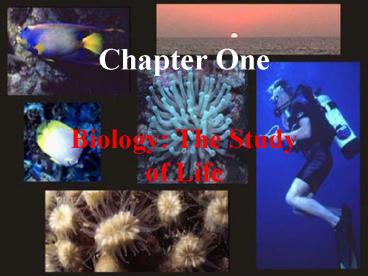Chapter One - PowerPoint PPT Presentation
1 / 44
Title: Chapter One
1
Chapter One
- Biology The Study of Life
2
I. Biology is the study of Life.
3
II. What do Biologist do?
- A. Study diversity of life
4
B. Research Diseases
5
C. Develop Technologies
6
D. Improve Agriculture
7
E. Preserve the Environment
8
III. Characteristics of Life
- A. Anything that has or once had all the
characteristics of life is known as an organism.
9
B. Characteristics Include
- 1. Composed of one or more cells
- Single-cell organisms have everything they need
to be self-sufficient. - In multicellular organisms, specialization
increases until some cells do only certain
things.
10
- 2. Displays Organization
- Both molecular and cellular organization.
- Living things must be able to organize simple
substances into complex ones.
11
(No Transcript)
12
- Living things organize cells at several levels
- Tissue - a group of cells that perform a common
function.
13
(No Transcript)
14
- Organ - a group of tissues that perform a common
function. - Organ system - a group of organs that perform a
common function. - Organism - any complete living thing.
15
(No Transcript)
16
- 3. Grows and Develops
- What is Growth?
- (1) Cell division - the orderly formation
of new cells. - (2) Cell enlargement - the increase in size
of a cell.
17
- b. What is Development?
- (1) all the changes that occur in life.
18
- 4. Reproduces
- Reproduction is not essential for the survival of
individual organisms, but must occur for a
species to survive.
19
All living things reproduce in one of the
following ways
- Sexual reproduction - Producing offspring by the
joining of sex cells.
20
- Asexual reproduction - Producing offspring
without the use of gametes.
21
- 5. Responds to stimuli
- Living things will make changes in response to a
stimulus in their environment.
22
- 6. Require energy
- Living things take in energy and use it for
maintenance and growth.
23
7. Maintains Homeostasis
- Organisms keep internal conditions stable.
24
- 8. Adaptations evolve over time
- Adaptations are traits giving an organism an
advantage in a certain environment. - Variation of individuals is important for a
healthy species
25
- Gradual accumulations of adaptations over time is
evolution.
26
IV. The Nature of Science
- A. Science is a body of knowledge based on the
study of nature and its physical settings.
27
- B. Theory-an explanation of a natural phenomenon
supported by observations and experiments over
time
28
- C. Science undergoes peer review -process by
which the procedures and results of experiments
are evaluated by scientists in the same field
29
- D. Science in Everyday Life
- 1. forensics
- 2. ethics - A system
- defining right and
- wrong.
30
- Here are just a few areas in life science that
involve ethics
31
Human life
- abortion
- euthanasia
32
Heredity - parents and offspring
33
Animal rights - animal rights vs human rights
34
Genetics
- - genetic engineering
- manipulating genes
- cloning
- stem cells
35
Use of the environment - at what financial cost
36
V. The Methods of Biology
37
A. Observing and Hypothesizing
- Inferences process of making logical
conclusions - Scientific methods used to gather information
to answer questions
38
B. Experimenting
- 1. Control group and experimental group
- 2. Independent Variable
- 3. Dependent Variable
- 4. Gathering Data
- (a) Numerical Data (quantitative)
- (b) Verbal Data ( qualitative or descriptive)
- 5. Analyze Data
39
C. Conclusion
- 1. Publishing
- 2. Verifying Results
- 3. Revising!!!
40
D. Tools used in Biology
41
(No Transcript)
42
(No Transcript)
43
(No Transcript)
44
E. Safety in the Biology Lab

